THE LANDSCAPING SOLUTIONS BLOG
Welcome to our Blog. Inspiration, updates and industry trends from the team at Landscaping Solutions.
BEWARE GREENWASHING
There are better ways to improve a company’s carbon footprint than carbon offsetting and mass tree planting schemes, says Landscaping Solutions MD Ben West.

Large companies will often offset their carbon footprint through mass tree planting schemes.
It’s wonderful to see once marginalised environmental issues becoming mainstream concerns, but we must ensure that action in these areas is both genuine and focused in the right direction. We must beware of ‘greenwashing’. Unscrupulous marketing departments have latched on to the fact that environment and sustainability issues are making headlines and are exploiting consumer naivety, a lack of consensus and toothless regulatory frameworks to increase sales and enter new markets. This seeds mistrust, confusion and apathy in the consumer. Research has shown that consumers can become indifferent or indeed harbour negative feelings towards green marketing, legitimate or otherwise, following sustained exposure to greenwashing.
Companies can declare sustainable credentials through carbon offsetting. What is carbon offsetting? In the simplest terms it is the balancing out of an individual’s or company’s carbon emissions by their funding an activity that involves the sequestering of carbon. A plane passenger travelling from London to Amsterdam can ‘offset’ a proportion of the carbon produced by that flight against the carbon sequestered by a tree planting scheme they have funded. Offsetting as part of a long-term plan for culture change is to be admired and encouraged but all too often these schemes are reminiscent of the absent father sending money to the kids whilst he’s away on ‘business’ with the secretary. Offsetting schemes assuage guilt without addressing the underlying issues - which is probably why fossil fuel companies like them so much.

Some airlines use tree planting schemes so they can offer passengers the opportunity to offset a proportion of the carbon produced by their flight.
Can we really buy our way out of the climate crisis? Carbon is best left where it is - in the ground. It’s not enough to carry on business as usual whilst throwing money at offsetting schemes which are at best well-intentioned but ineffective and at worst cynical and damaging. A better policy is to protect existing natural systems whilst rewilding wherever possible. The best way to plant trees is to allow them to regenerate naturally. Jays and squirrels plant trees throughout the autumn for free. This is much more sustainable than armies of trees planters driving to remote sites and much more likely to succeed.
Take a look at the images of HS2’s failed attempts to greenwash the impact of their atrocities in the Chilterns; fields full of plastic tubes containing dead and dying saplings. Remember that the thorn is the mother of the oak; a tangle of thorny scrub (possibly the most undervalued of all our native habitats), consisting of hawthorn, dog rose, blackthorn and bramble is a far more effective nurse to the species that will eventually become climax woodland: ash, oak and beech.
In any case we shouldn’t get too fixated on tree planting as a panacea for all our climate and biodiversity ills. We need a diverse mosaic of habitats to contribute to carbon fixing and biodiversity gains. Woodland is well down the pecking order when it comes to holding carbon in the landscape. Seagrass meadows, mangroves and salt marshes are all examples of habitat that are ahead of woodlands in the carbon fixing stakes. Top of the list are peatlands: tundra, bogs, fens, moorland, meres and mires. These are the very habitats that some elements of our industry are keen to see relocated and releasing carbon in pots, planters and borders up and down the country. We damage these habitats, and unlock carbon in the process, when we disturb them. Disturbance includes planting trees on them, as well as on heathland, ancient woodland and a host of other fragile and threatened habitats. This has happened throughout the twentieth century in this country and may continue should we blindly pursue ill-conceived carbon offsetting schemes or political promises geared to gaining the popular vote at the ballot box.
ILLUMINATING THE PROBLEM
How damaging is artificial lighting to the environment? Landscaping Solutions MD Ben West considers the impact.

Artificial light can adversely impact the behaviour of birds.
We don’t have lighting in our garden. The generosity of the local borough council is such that all the light we need, and pools more, is gathered from an adjacent lamp post. Indeed ‘light trespass’ from this single luminaire infuses evening al fresco dining with all the charm of a Gestapo interrogation. The offending street lamp has recently been limited to operation from dusk until midnight, presumably as a cost cutting measure but possibly also as a response to emerging evidence of the negative effects of artificial light on the environment.
Recent studies, particularly those undertaken by the Environment and Sustainability Institute at the University of Exeter, have revealed artificial light to be adversely impacting the behaviour of a much wider range of species than myself and the missus. Birds are particularly affected with physical reproduction traits and behaviours being modified. Bird movements are also being disrupted, along with those of bats and fish, as navigational ‘signposts’ such as starlight, moonlight and diffuse natural light in the atmosphere are obscured or obliterated by ‘Skyglow’ from artificial light. This phenomena is observable many miles from source, can be equal to or exceed light intensities produced by moonlight and sufficient to mask natural lunar light cycles.
Light pollution is a relatively new phenomenon so the long term effects on biodiversity are unknown. However, the short term effects are obvious; leave a window open on a summer’s evening and it’s clear that artificial light has an effect on night flying insects such as moths. Is there a link between the reported declines in moth numbers over the past thirty years and the increase in artificial lighting during the same period? It’s too early to answer questions like these definitively but it’s easy to test the hypothesis; switch out the lights and the problem disappears. Knowing the detrimental effects on wildlife, can we continue to freely prescribe lighting in our design work? Maybe it’s time for a more measured approach. Let’s look at the facts;
The relative impact of different types of lighting depends on where they are on the spectrum. Different kinds of lamp emit light over a distinctive range of wavelengths. Light becomes more environmentally impactful in the following ways;
a) As it becomes broader on the spectrum (or ‘whiter’).
b) As the ratio of blue to red emissions increases.
c) With increased emissions in the UV (ultraviolet) range.
The broader the spectrum the more overlap with the sensitivity of biological systems. Lighting toward the red end of the spectrum is generally thought to be less impactful to the environment though this also has a bearing on the ability of birds to migrate and has an effect on plant physiology.
Light-emitting diode (LED) lighting systems require lower wattage than traditional light sources and produce lower radiant heat for the same light output. They have a longer working life and allow easy light level manipulation. Unfortunately they utilise white light which is disruptive to natural systems and the blue component is disruptive to human circadian rhythms.
So what should we be doing as environmentally conscious professionals?
- Maintain naturally unlit areas wherever possible.
- Specify light only where there is clear, sufficient and necessary human benefit. - Provide barriers to ‘light trespass’ such as covers or hoods, walls, screens and evergreen hedges.
- Ensure lighting is switched on only when needed by utilising motion control
- Disseminate knowledge to clients to raise awareness.
- Use LED lights on as dim a setting as possible.
- Avoid use of white and blue lights and fittings which emit UV light.
NATURE’S SPOILS
Landscaping Solutions MD Ben West details the ‘rewilding’ of his own garden, from which he, his family and the local wildlife have already reaped rewards.

Rewilding your garden greatly benefits local wildlife.
Last month, we explored the concept of rewilding as an antidote to biodiversity loss and mitigation against the most damaging effects of climate change. I promised to share a snapshot of my garden’s ‘rewilding’ journey, which has so far consisted mainly of adopting a more relaxed attitude to maintenance practices and allowing ‘weed’ species to establish alongside ornamentals.
This approach has greatly benefitted local wildlife and helped my family develop a deeper connection to nature. Through learning the traits and practical applications of the various wild plants that have taken up residence, they have a visceral understanding of nature’s interconnectedness and their place therein. Modern life lived through these eyes is a blessing and a curse. There is truly never a dull moment.
Early in the year, hairy bittercress, dandelion and sow thistle add cleansing and nutritional value to our salads. We rejoice in the emergence of wild garlic and include it in all our cooking. Bright rays of flowering coltsfoot attract the first insects of spring such as the intriguing bee fly. Flowering ground ivy, herb robert and white dead nettle provide uplifting herbal teas.
Moth caterpillars start to show with angle shades feeding on self-seeded buddleia and broad- bordered yellow underwing hiding amongst patches of Cleavers. This plant epitomises the rising of the sap and we drink its juices to cleanse our lymphatic system and shift our metabolisms out of their winter torpor.
Orange tip butterflies are attracted to garlic mustard and we share their caterpillars’ liking for its leaves. They also lay eggs on cuckoo flower which lends a wasabi kick to our salads. Nettles have become a staple food now. Full of nutrients, they combine with fresh vegetables to form the basis for our favourite soup and also feed the larva of the Vanessid butterflies; Red Admiral, Small Tortoiseshell, Comma, Peacock and Painted Lady. Their split stems are weaved together to form cord from which trinkets are dangled from children’s necks and wrists.
Bird nesting begins in earnest and our ivy clad fence is well appreciated. Swift boxes set in the brickwork of our gable end fail to attract their target species but are taken up by house sparrows which enjoy the seeds of self-sown oxalis in the borders. Their constant chattering, at odds with the melancholy flute of the blackbird and the quicksilver outpourings of the blackcap in the willow, form the soundtrack to summer.
We embrace unloved elder by making refreshing summer drinks with its flowers and later medicinal syrups with its berries - blackbird and blackcap love it too. The plants that attract the most life are those that have found their own way here, none more so than the much maligned ragwort which is the centre of all insect activity throughout its long flowering period. Burnet companion, mother of pearl and cinnabar moths (and their caterpillars), gatekeeper and meadow brown butterflies and a host of parasitic wasps, hoverflies and bee species are in constant orbit.
I let fade away anything that fails to fend for itself and allow survivors to thrive; purple toadflax is one such survivor and attracts streams of bees through summer including the charismatic wool carder bee. By night, it is festooned with mother of pearl moths and garish toadflax brocade moth caterpillars. The almost identical larvae of the mullein moth can be found feeding on the foliage of its self - seeded namesake alongside pupating ladybird larvae. Shield bugs are up to no good in the shadows; stag beetles stick to the bricks of the house and demoiselles, damselflies and dragonflies clatter through the deepening foliage.
All life is here amongst these summer weeds. Wild medicinal herbs turn up and are infused to make teas: yarrow for sore throats, plantain for coughs, fennel for digestion and mugwort for lucid dreaming. Others are harvested and preserved in alcohol as tinctures to last through the winter: dock root, St John’s wort flowers and prickly lettuce leaves will treat everything from excitability to lethargy. Prickly lettuce also provides food for small ranunculus moth larvae. The reviled creeping thistle is a great nectar source for late summer insects and now attracts brown hairstreak butterflies to the garden. Grass snakes slither into the compost heap to lay eggs and hunt for rodents.
Moth numbers are peaking and a trap set up at night is a revelation. We are dazzled by the diversity of colours, patterns textures and forms. As summer flowers fade into autumn, dark bush crickets continue to fill the night air with whispering chirrups. At this time, ivy comes into its own. Its late emerging flowers are a major fuel source for insects. Stand beside a spunk scented spray on a sunny day in early autumn to see insect theatre play itself out before you. We really must regain our reverence for this plant.
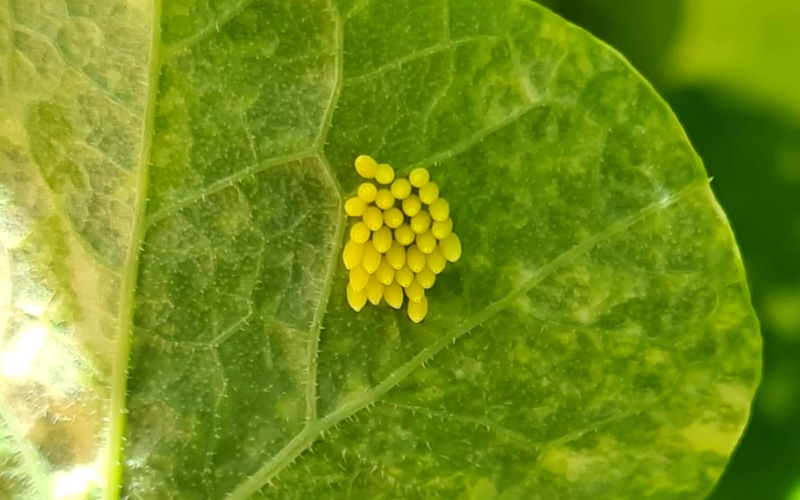
Large white butterfly eggs.
One image of the unfurling year sticks in my mind. In the spring, I scattered nasturtium seeds in the corner of a raised planter and the rapidly developing foliage became a welcome addition to salads and pesto. Large white butterflies came to lay eggs on the undersides of the leaves. A great life lesson in lockdown for the kids as we observed the eggs through to the larval stage.
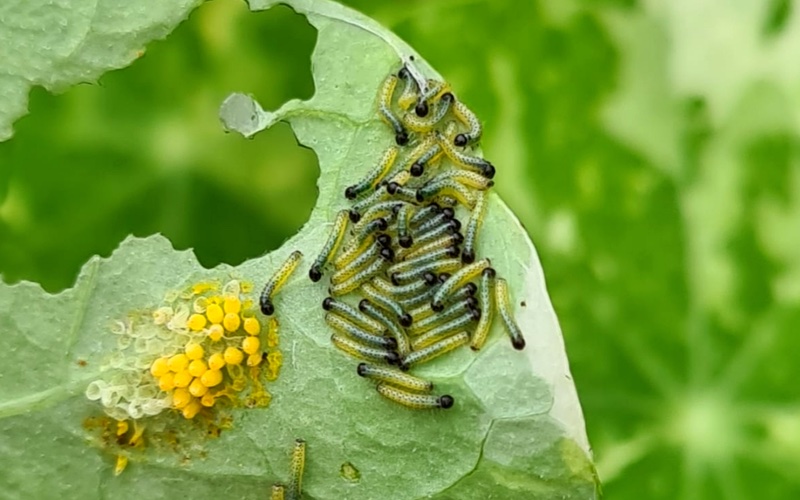
Emerging caterpillars on the underside of a nasturtium leaf.
The kids liked the fact we shared the caterpillars love of the peppery vegetation. As they dispersed to pupate, we searched for, and found, a cocoon and marvelled as the emerging imago pumped up its wings and flew away to continue the cycle.
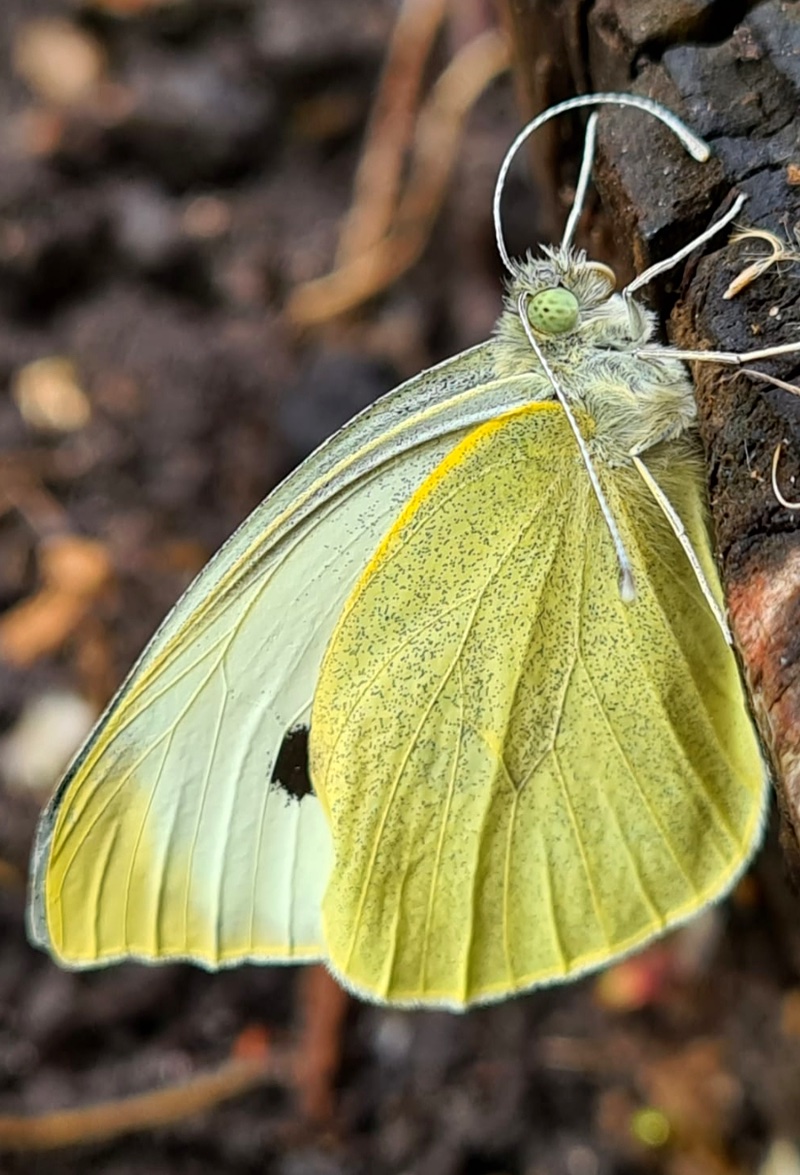
Large white adult Imago.
I wonder if, by embracing rewilding, we are like the caterpillar that, having stripped its food- plant bare and seemingly painted itself into a corner, now undergoes a strange and remarkable metamorphosis to emerge as a useful enhancement to the ecosystem and a jewel for the eye.
One thing is for sure; if the garden had been weeded, much of this richness of life would have been lost and never had the chance to enrich our lives so profoundly.
You can continue to follow Ben’s journey on Instagram: @wearewherethewildthingsare
THE RISE OF REWILDING
Rewilding is fortunately gaining traction, says Landscaping Solutions MD Ben West, and we all need to embrace it.
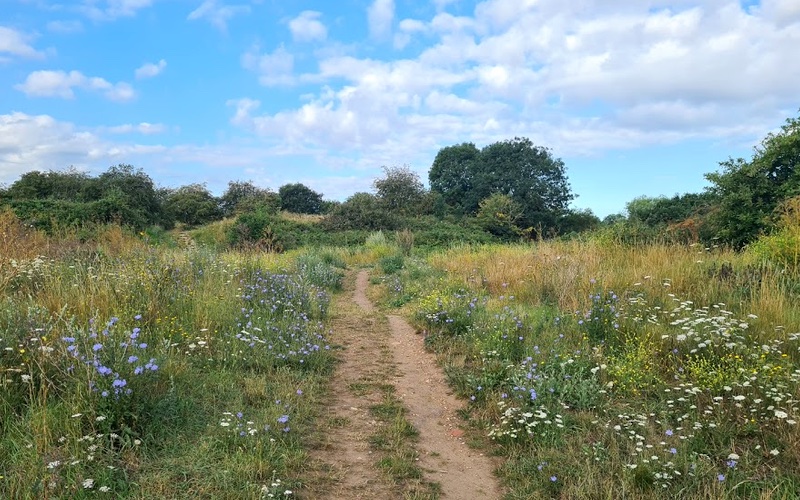
Embracing the concept of rewilding will help reduce biodiversity loss.
Of all the global-scale predicaments we currently face, I find biodiversity loss to be the most pernicious. The systematic, often wilful degradation of the source of our being and the accompanying depletion of the myriad wonders with which it is bejewelled, represent a deep source of personal pain and sorrow.
Furthermore, it’s an embedded phenomena. In 1987, I joined the Young Ornithologists’ Club and from the outset was haunted by the spectre of declining bird numbers reported through the pages of its quarterly publication. Later, I developed an interest in botany and lepidoptera and discovered these beset with the same issues: habitat destruction, poor land management, pollution and pesticides.
Across the board, it seems our relationship with nature is a dysfunctional one. This is doubly troubling for those of us who’ve had their lives immeasurably enriched through a love of nature, yet find ourselves complicit in its destruction by dint of being active in a system geared to that end. I’ve been carrying this baggage around for years. None of my school friends or subsequent work colleagues seemed conscious of these problems nor did they appear to care once awakened to them. Older folks, my parents included, dismissed the losses as collateral damage in the wake of ‘progress’. “Toward what?” I asked. A question invariably met with silence or a shrugging of shoulders.
However, lately it seems something has shifted. Awareness has spread and with it a commitment to change. Shoulders that once shrugged now seem set to carry the weight of the work ahead. Solutions are coming to the fore, most promisingly in the form of ‘rewilding’; the idea that depleted landscapes can be regenerated by allowing natural processes to re-emerge. In fact, it’s inaccurate to call rewilding an ‘idea’ as it’s now a proven model across Europe and well established in Britain as evidenced by the Carrigan Wildwood, Glenfenshie and Abernethy projects in Scotland and Ennerdale in northern England. The astonishing biological resurrection of the flagship British rewilding programme at the Knepp estate in Sussex and the bestseller status of ‘Wilding’, the story of its genesis by Isabella Tree, suggest this movement may be ready to roll out across the lowlands of southern England. Most recently, the ambitious WildEast initiative has pledged to rewild 250,000ha of East Anglia whilst simultaneously pushing the concept beyond the physical landscape and into the cultural practices and everyday lives of the areas’ inhabitants.
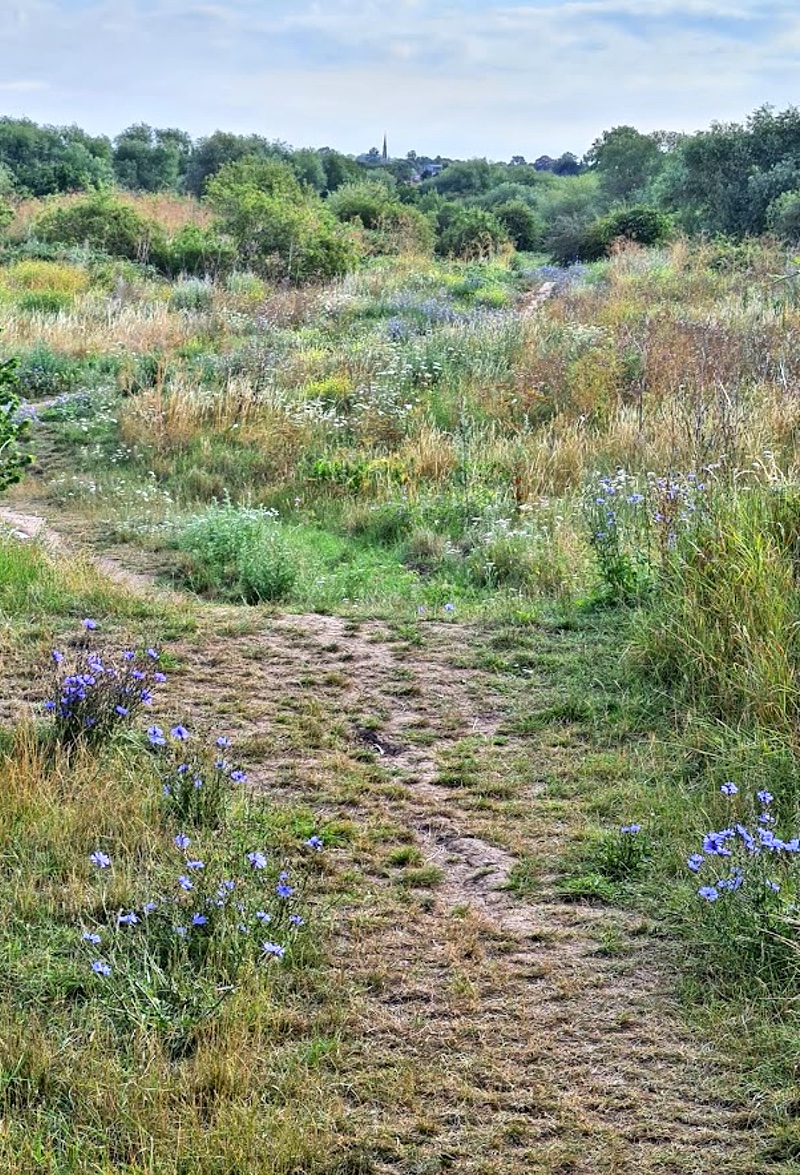
Rewilding allows once depleted landscapes to regenerate.
The acknowledgment of this cultural aspect emphasises a key point; rewilding is not just about the reinstatement of bison, beavers and wolves; nor does it necessitate the acquisition of vast tracts of land. Rewilding works on all levels to weave together the unravelled warp and weft of life’s rich tapestry and recognises humanity as an important thread.
Rewilding is also about wresting back dominion over consciousness from deceptive forces. We must first rewild ourselves before we can rewild our planet. What does that mean? Well, I’ve written previously on the Landscaping Solutions blog, of the need to relinquish our received wisdom around what constitutes ‘good gardening’ and acknowledge that we have increasingly been led down the garden path by snake oil salesmen. If you’re looking for evidence, consider how the ‘garden centre experience’ has changed over the past 30 years or so. Too many of our established practices are turning gardens into biological deserts when they are often the last refuge for wildlife in the face of habitat loss. As a reaction to this, I have, over the last couple of years, embraced the concept of rewilding in my own modest plot, and next month I shall share my experiences of that journey with you.